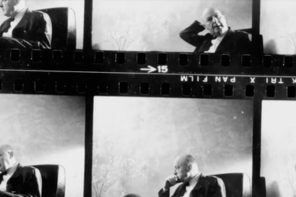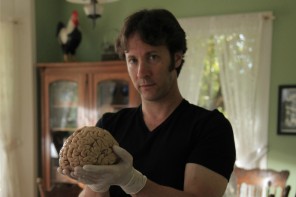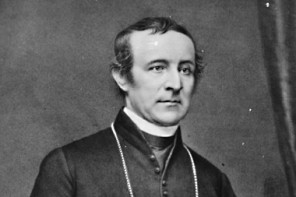In his 1967 book Israel: An Echo of Eternity, Abraham Joshua Heschel refers to “the jungle of history.”
An interesting locution, and apt. A jungle is a place where things seem to co-exist against all odds—nature at its best and most beautiful, but also at its worst and most vicious.
If history is a “jungle”—nature at its most beautiful but also its most unforgiving—then an historian is an explorer: she must try to make order of chaos and find meaning in dense overgrowth. It is thus appropriate that Ben Loeterman’s new film “1913: Seeds of Conflict” deploys an agricultural metaphor.
History is a jungle.
The film, premiering June 30 on PBS, consists of rare and often striking footage of early twentieth-century Palestine, mostly taken from a newly discovered film from 1913: Noah Sokolowsky’s, “The Life of Jews in Palestine.”
Loeterman’s film offers this footage along with interviews with a team of experts and short dramatizations featuring significant individuals of the time. The script of these dramatizations is taken directly from letters, court cases, and speeches, all in their original languages (with subtitles). While such dramatizations can often seem trite or contrived, they are used quite effectively in the film. Even hearing the Arabic, German, French, Hebrew and Turkish gives one a feel for the multiethnic dimension of this particular corner of the jungle.
1913 is not a year many point to as the germ-cell of the Israeli-Palestinian conflict. But Loeterman suggests that it is; not in any obvious way, no seismic event, national conflict or political edict. Rather, three things happened in 1913 that frame this film.
First, Sokolowsky’s film “The Life of the Jews in Palestine” was made, containing the earliest moving images of Palestine; second, Arthur Ruppin’s speech at the Zionist Congress that year focusing on “conquest of the land” through land purchasing that set the Zionist nationalist agenda on a new course; and third, a local skirmish between an Arab who stole some grapes near the Jewish colony of Rehovot on his way to selling his produce and a Russian-Jewish guard who beat him brutally not for, as the guard later said, “stealing grapes from a Jewish colony but stealing grapes from the Jewish people.” Two people died: one jew and one Arab.
Loeterman’s film argues that this local skirmish was a match that ignited a fire. But to understand why Loeterman argues we must return to the jungle of history that is Ottoman Palestine in the late nineteenth and early twentieth century.
The story of “1913: Seeds of Conflict” begins on a politically mundane, yet artistically fascinating, note. Film archivist Yaakov Gross is informed that in a warehouse in France a few boxes of old films of Palestine were discovered. In those boxes was a film that depicts Jewish life there in 1913. It is one of the earliest moving images from Palestine. After World War I the film had vanished and was thought lost.
Like many propaganda films made after it, Sokolowsky’s film depicts burgeoning life in the Jewish colonies, or small agricultural towns, that dotted the lower plains at that time (the more fertile land was in the mountains where most of the Arab population lived). It also shows a bustling multiethnic and largely peaceful Jerusalem at a time before the four quarters (Armenian, Christian, Jewish, Muslim) separated its inhabitants into veritable enclaves.
And like many of the films that would come later, it rarely depicts Arabs—who at that time were the large majority of the population.
These were films meant to promote the common Zionist myth first coined by the British Jew Israel Zangwill, “A land without a people for a people without a land.”
Examining one clip of a bustling Jewish colony in the film, the narrator stops to ask Gross, the archivist, about figures in the distance at the top of the frame, almost silhouettes, standing on a hill. “Who were they?” the narrator asks. Gross answers, “I don’t know.”
Of course, they were Arab villagers watching the filming from a safe distance. Gross’s “I don’t know” echoes throughout the film. And thus the story begins.
The film does a good job going through the various Jewish immigrations that took place from the 1890s—beginning with the pogroms in the aftermath of Czar Alexander’s assassination in Russia in 1881, through the First World War, as Jews left Europe in increasing numbers. During this period, Zionism was still a nascent movement (during this period of immigration only 5% of Jews ended up in Palestine. Most immigrated to the US).
Yet slowly Zionism begins to take hold of a Jewish population, many of whom did not have nationalist aspirations, wishing simply to live a relatively secure life in the Holy Land. But the worse things got in Europe the more Zionism became a viable alternative—itself an expression of the density of this historical jungle, where things feed on that which seeks to destroy them.
Theodore Herzl knew this quite well when he wrote in his The Jewish State (1896) that “the misery of the Jews will be Zionism’s propelling force.”
Interspersed with both Jewish and Muslim academic experts on Zionism, the Arab Middle East, and the Ottoman Empire, this film offers a complex picture of a situation that went very wrong for reasons that all-too-often had nothing to do with either Jews or Arabs (later called Palestinians).
In this early period they were all simply Ottomans, subjects of a dying kingdom.
The Young Turk Revolution in 1908 transformed the empire, already crumbling, from a centralized system of government to one that viewed the French Revolution as its model. Jews and Arabs in Palestine largely welcomed this revolution and viewed it as a positive step toward self-expression (not yet self-determination).
But something else began to happen. The mostly Sephardic Jews who lived in Palestine before the second large Jewish European immigration (known as the Second Aliyah) in 1904-1914 were suspicious of these European Jews with their “Zionist” ideas who did not want to integrate into the empire.
Zionists, and also Palestinian Arabs, began to see the 1908 revolution as an opportunity to distance themselves from the empire altogether. As an illustration of this we meet an important figure, Albert Antébi, a Syrian Jew who played a crucial role in mediating between the Ottomans, the Sephardic communities, and the Zionists.
Antébi was a devoted subject of the sultan, a proud Jew who identified as an Ottoman who encouraged the new Jewish immigrants to do the same. Like the Arabs, he saw what was happening as the first decade of the twentieth century progressed: Jewish self-expression was becoming Jewish self-determination.
The Young Turk Revolution helped create the space for Zionism to take root in Palestine. But that same social context also gave rise to new Arab newspapers such as El Carmel and El Palestine, around which coalesced a collective Palestinian identity. These papers openly challenged the Zionist project (not the “Jews”) and warned the Arabic-reading public of an ensuing confrontation.
As Rashid Khalidi argues in his book Palestinian Identity (2009) Loeterman suggest that Zionist and Palestinian identity emerge simultaneously in Palestine as the Ottoman empire experienced upheaval and eventual collapse.
The film depicts the turn from self-expression to self-determination among Zionists in three areas: Jewish purchase of Arab land from largely absentee land owners, the “Jewish labor” movement of the Second Aliyah (1904-1914), and the increasingly demeaning attitude many of the Zionist colonists had toward the indigenous Arab population (perhaps more a legacy of their identity as Europeans than their Jewish pedigree).
The central figure in the first case was German-Jewish immigrant Arthur Ruppin (1876-1943) who developed an intricate plan of Jewish colonies that would create an infrastructure of a future state. In 1890 this came to a head with a land dispute between members of the Jewish colony of Rehovot and Bedouins who had been living and farming that land (but had no Ottoman deed to prove ownership). The Jews bought the land outright and demanded the Bedouins leave without compensation. The Bedouins refused.
The case went to the Ottoman courts in Istanbul, but jurists threw it out of court deeming it a local dispute not worth addressing. The Bedouins had to leave and Rehovot continued to expand.
And thus seeds of conflict were sown. The Arabs began to realize what was happening and they knew the Ottomans had no real interest in intervening. The Arab press in Palestine lambasted the absentee Arab land owners who were selling the land to the Jews at an inflated price, but to no avail. Those landowners had mostly left before the birth of any real national consciousness among the Arabs in Palestine.
The Jewish labor movement was largely the brainchild of the Second Aliyah immigrants, the first “Zionist” immigration that gave rise to the Kibbutz movement. They wanted to create a society where the Jewish, and not Arab, worker created the infrastructure for their Jewish society. While done with ostensibly moral intentions, as Edward Said notes in The Question of Palestine, it also marginalized the Arab worker who stood by and watched a modern society blossom while he remained mired in a largely pre-industrial world.
As important, the film argues that the Jewish labor movement changed the relational dynamic from local to national. Arabs rightly felt that their land was no longer being used for Jewish colonies; it was now being used for a national project. Ruppin knew this and it greatly concerned him. His speech at the Zionist Congress in 1913 about “conquest of the land” through practical means contributed to a shift in emphasis of the Zionist movement. Pragmatics trumped co-existence. Ruppin wrote about the dangers of alienating the Arab majority, in one letter even suggested he “may have gone too far.”
But in the jungle once things start to grow it is very difficult to stop them.
The attitude toward the Arab is the third major focus of the film. As one expert noted, in the early Zionist imagination, the Arab was not a person but a part of nature (a part of the jungle). There was a stone, a tree, and an Arab. They were part of the landscape, considered nomadic, and not a functioning society.
One can see this is some of the early collections of photographs of Palestine published by Jewish photographers. It is what we would later call Orientalism. Zionists such as Ahad Ha-Am (Asher Zvi Ginsberg 1856-1927) wrote passionately against this, not only on moral grounds but also because, like Ruppin and even like Antébi, he knew its consequences. Unless things change, Ahad Ha-Am argued, the Arab will become the enemy.
The film gives us a very cogent view of all these moving pieces that culminates in the 1913 theft of grapes that resulted in the deaths of an Arab and a Jew. The national struggle had its first casualties. Both sides knew it. And both sides wanted a peaceful resolution. They knew the Ottomans didn’t care anymore, they had bigger problems.
Negotiations began —it was a real moment of communication.
But then something came to disrupt this opportunity: World War I began. All attention turned elsewhere. It had been an opportunity, perhaps, a way to stop the ball from rolling out of control. Instead, like the 1913 film, it was a forgotten shrub, trampled on by the boot heels of history.
From our vantage point in 2015, many wars later, many deaths later, many failed attempts at resolution later, this film has an arresting quality. All sides are to blame. No sides are to blame. Fate is to blame. History is to blame.
The lack of hindsight on all sides was only a little worse than the lack of foresight. Things just happened too fast. From the Young Turk revolution in 1908 until the outbreak of World War I in 1914 is only six short years. Yet in that brief span contingencies narrowed, ideologies took root in the rocky soil, local became national, and communal self-expression became national self-determination.
The film shows that all the major parties (except perhaps the Ottomans who were busy managing their own demise) knew what was happening. And yet nothing was done, or could have been done, to stop it.
The film, I think, invites us to take a closer look at the Arab fellahin standing in the distant hills in the top of the frame of Sokolowsky’s 1913 film. This is not to take sides, and I think the film does an excellent job not taking sides; it is rather to see how things could have been before they became what they were. Things could have been different, and along the way many on both sides knew it and futilely tried to warn the parties involved.
But history is a jungle and rarely yields to reason. Somewhere toward the end of the film, Amy Dockster-Marcus says in passing “we can’t control history.” Is that true? We make history, we are history.
Perhaps it is because history is only after-the-fact; history only enters when the damage is already done.
Rabbi Joseph Soloveitchik once wrote, “The past is indeterminate, a closed book. It is only the present and future that can pry it open and read its meaning.” History is a crowbar. Marcus asks early on in the film, “was there a turning point, a moment in time…when things could have been different?”
The answer, of course, is yes; it is always yes. But why does that matter? I’m not quite sure. “1913: Seeds of Conflict” forces us to take a serious look at that question.





